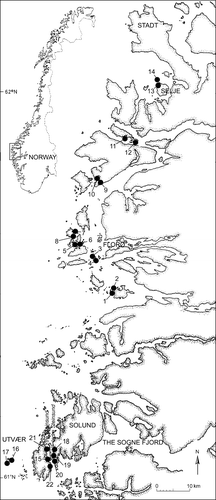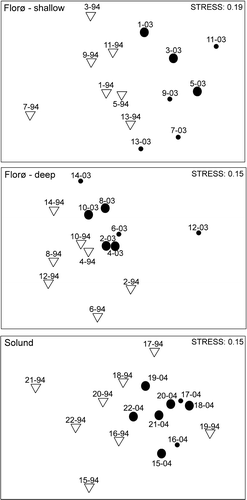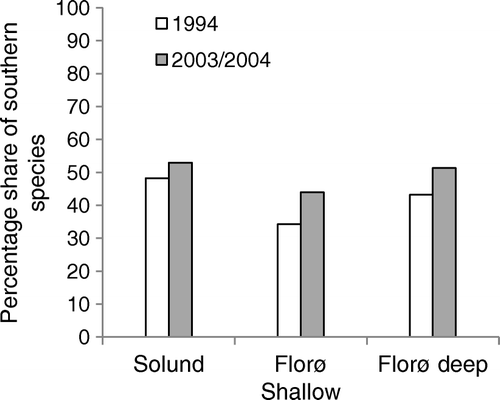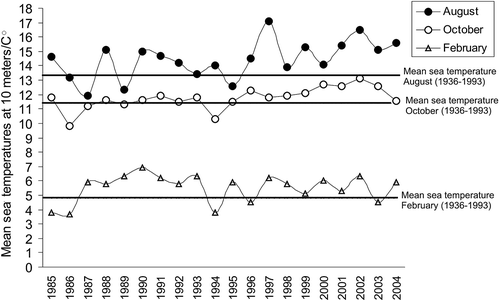Figures & data
Figure 1. Positioning of 22 sites at the Norwegian west coast, where the subtidal macroalgal communities were previously mapped in August 1994–1995, and reinvestigated in August 2003–2004 (Map drawing: Elin Holm).

Figure 2. Macroalgal species richness represented by the presence of species at subtidal sites in Sogn and Fjordane investigated in 1994 and in 2003–2004. Sites 1–14 are situated in the Florø–Stadt area and sites 15–22 are situated in the Solund area. Open squares = 1994–1995; filled squares = 2003–2004. X = the abundance of Heterosiphonia japonica on sites in 2003–2004 recorded on a semi-quantitative scale where 0 = not found, 1 = rare (one or a few specimens), 2 = common (many specimens, estimated to <10% of the total algal biomass), 3 = plenty (estimated to > 10% of the total algal biomass).

Figure 3. Two-dimensional MDS (non-parametric multi-dimensional scaling) ordination showing Bray–Curtis similarities for: A. Seven sites in the shallow interval (5–15 m) in the Florø–Stadt area investigated in 1994 and 2003. B. Seven sites in the deep interval (16–28 m) in the Florø–Stadt area investigated in 1994 and 2003. C. Eight sites in the Solund area investigated in 1994–1995 and 2004. Depth ranges at these sites were between 4 and 30 m. The last two numerals in the labels represent the year of sampling. The abundance of H. japonica is illustrated with a large black circle where the species was common or plentiful.

Table I. Species contributing to 60% of the similarity between sites in 1994/1995 and 2003/2004 determined by SIMPER analysis. Shallow interval = 5–15 m deep, deep interval = 16–28 m deep, all depths = 4–30 m deep.
Table II. Average abundance of species contributing to approximately 30% of the net dissimilarity in macroalgal assemblages in the Florø-Stadt and Solund area between years (1994 and 2003/ 2004) determined by SIMPER analysis. Species marked: (S) = species with a southern distribution in Norway; (X) = species that occurs along the entire Norwegian coastline. Shallow interval = 5–15 m deep, deep interval = 16–28 m deep, all depths = 4–30 m deep. (AA= average abundance ranging on a scale from 0 to 1, where 1.00 means that the species is present at all sites.)
Figure 4. The percentage share of species with a southern distribution on the Norwegian coast as a total of all species collected in the two studies (1994–2003/2004).

Figure 5. The mean seawater temperatures measured at 10 m at the outlet of the Sognefjord in August (warmest month), October and February (coldest month). Normal seawater temperatures during August, October and February (shown as vertical lines) are mean seawater temperature in the period 1936–1993 (Aure & Strand Citation2001).
